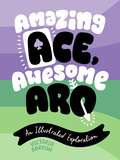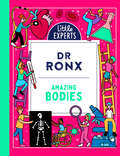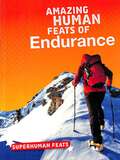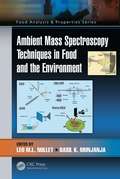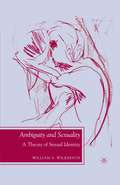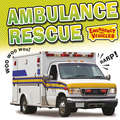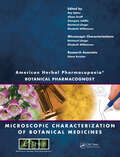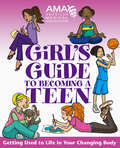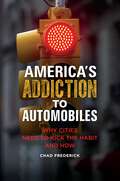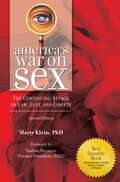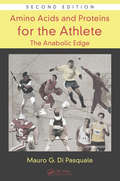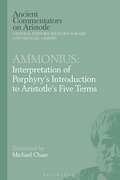- Table View
- List View
Amazing Ace, Awesome Aro: An Illustrated Exploration
by Victoria BarronThe split attraction model? Alterous Love? Queerplatonic relationships?From the creator of Perfectly Queer: An Illustrated Introduction, this bold and brilliantly illustrated guide is written for anyone looking to explore the beautiful ace and aro communities; the acefluxes, the arospikes, the demis, the greys, the frays and more. Separate the myths and stereotypes, and discover some of the wonderful intricacies that shape each spectrum, including: forms of love and attraction, common identities, microlabels, flags, and the entertaining community-led culture. Packed with quizzes, activity sheets and a directory of further resources, this is a celebration of all things ace and aro!
Amazing Bodies (Little Experts #2)
by Dr RonxInspired by the incredible human body? Take a tour with award-winning trans non-binary emergency doctor and TV presenter DR RONX – from spongy brains to gooey guts and everything in between.
Amazing Human Feats Of Endurance (Superhuman Feats)
by Haley S. JohnsonEndurance is the power to keep going even when something is hard. Read this book to discover the greatest feats of human accomplishment as they test themselves to their limits of endurance.
Amazing Yoga: Amazing Yoga (Flash)
by Swami SaradanandaThe books in this bite-sized new series contain no complicated techniques or tricky materials, making them ideal for the busy, the time-pressured or the merely curious. Amazing Yoga is a quick, no-effort solution for those who want to reap the benefits of an ancient art quickly and easily. In just 96 pages, readers will discover the basic poses and principles of yoga and learn how to put them to good use.
Ambient Mass Spectroscopy Techniques in Food and the Environment (Food Analysis & Properties)
by Leo M.L. Nollet Basil K. MunjanjaAmbient mass spectrometry—that is the use of mass spec but in the atmospheric environment—has been widely employed in food and environmental analysis. Ambient Mass Spectroscopy Techniques in Food and the Environment presents the theoretical underpinnings of mass spectrometry, and the benefits and pitfalls of ambient mass spectrometry, as well as the latest developments of the technique, in the analysis of food and environmental parameters. It describes methods that enable the detection of surface materials like waxes, alkaloids, flavors, or pesticides by plainly exposing the corresponding items to the ionization region of the interface, without harm to samples. Features: Explains the theoretical aspects of ambient mass spectrometry Describes how to use ambient MS techniques for food safety, authenticity, and traceability screening Lists the benefits of ambient MS in analysis of food and environmental parameters Covers recent developments of ambient MS in analysis of food and environmental parameters The specialized work provides insight to professionals practicing in food and the environment, including food scientists, food engineers, food biotechnologists, chemical engineers, and those working in research labs, universities, and government regulatory agencies.
Ambient Mass Spectroscopy Techniques in Food and the Environment (Food Analysis & Properties)
by Leo M.L. Nollet Basil K. MunjanjaAmbient mass spectrometry—that is the use of mass spec but in the atmospheric environment—has been widely employed in food and environmental analysis. Ambient Mass Spectroscopy Techniques in Food and the Environment presents the theoretical underpinnings of mass spectrometry, and the benefits and pitfalls of ambient mass spectrometry, as well as the latest developments of the technique, in the analysis of food and environmental parameters. It describes methods that enable the detection of surface materials like waxes, alkaloids, flavors, or pesticides by plainly exposing the corresponding items to the ionization region of the interface, without harm to samples. Features: Explains the theoretical aspects of ambient mass spectrometry Describes how to use ambient MS techniques for food safety, authenticity, and traceability screening Lists the benefits of ambient MS in analysis of food and environmental parameters Covers recent developments of ambient MS in analysis of food and environmental parameters The specialized work provides insight to professionals practicing in food and the environment, including food scientists, food engineers, food biotechnologists, chemical engineers, and those working in research labs, universities, and government regulatory agencies.
Ambiguity and Sexuality: A Theory of Sexual Identity (Future of Minority Studies)
by W. WilkersonA new account of the formation of sexual identity, coined 'emerged fusion', which avoids the traps of the essentialism versus constructivism debate, and offers a viable third alternative. This book is a theoretical tool that will be useful in sociology, queer studies, and gender studies as a new approach to understanding sexual identity.
Ambulance (Large Print)
by RnibThe ambulance is viewed from the side with only two of its four wheels showing at the bottom of the image. There is a locator dot shown, which will be at the top left of the page when the image is the right way up. The front cab of the ambulance is on the left of the page and the rear on the right. Towards the lower front of the ambulance there is one headlight, and up from this the emergency vehicle reflective strip runs the entire length of the vehicle. The curved edge of part of the front windscreen is shown just above the reflective strip at the left. To the right of this is one of the cab's doors with a window in it. There is a mirror in the bottom left corner of the window. The door handle is near the bottom right corner of the window. Up from the door at the top of the vehicle is the blue emergency light. In the centre right of the image is a darkened window. On the far bottom right of the ambulance is the rear light.
Ambulance Rescue: Ambulance Rescue (Emergency Vehicles #3)
by Deborah ChancellorAmbulances speed past with bright lights flashing as they race to the rescue... Lots of noisy words and plenty of high-speed action introduce emergency vehicles and other life-saving equipment in a lively and exciting way.
Ambulance (UEB Contracted)
by RnibThe ambulance is viewed from the side with only two of its four wheels showing at the bottom of the image. There is a locator dot shown, which will be at the top left of the page when the image is the right way up. The front cab of the ambulance is on the left of the page and the rear on the right. Towards the lower front of the ambulance there is one headlight, and up from this the emergency vehicle reflective strip runs the entire length of the vehicle. The curved edge of part of the front windscreen is shown just above the reflective strip at the left. To the right of this is one of the cab's doors with a window in it. There is a mirror in the bottom left corner of the window. The door handle is near the bottom right corner of the window. Up from the door at the top of the vehicle is the blue emergency light. In the centre right of the image is a darkened window. On the far bottom right of the ambulance is the rear light.
Ambulance (UEB Uncontracted)
by RnibThe ambulance is viewed from the side with only two of its four wheels showing at the bottom of the image. There is a locator dot shown, which will be at the top left of the page when the image is the right way up. The front cab of the ambulance is on the left of the page and the rear on the right. Towards the lower front of the ambulance there is one headlight, and up from this the emergency vehicle reflective strip runs the entire length of the vehicle. The curved edge of part of the front windscreen is shown just above the reflective strip at the left. To the right of this is one of the cab's doors with a window in it. There is a mirror in the bottom left corner of the window. The door handle is near the bottom right corner of the window. Up from the door at the top of the vehicle is the blue emergency light. In the centre right of the image is a darkened window. On the far bottom right of the ambulance is the rear light.
American Dementia: Brain Health in an Unhealthy Society
by Daniel R. George Peter J. WhitehouseHave the social safety nets, environmental protections, and policies to redress wealth and income inequality enacted after World War II contributed to declining rates of dementia today—and how do we improve brain health in the future?For decades, researchers have chased a pharmaceutical cure for memory loss. But despite the fact that no disease-modifying biotech treatments have emerged, new research suggests that dementia rates have actually declined in the United States and Western Europe over the last decade. Why is this happening? And what does it mean for brain health in the future?In American Dementia, Daniel R. George, PhD, MSc, and Peter J. Whitehouse, MD, PhD, argue that the current decline of dementia may be strongly linked to mid–twentieth century policies that reduced inequality, provided widespread access to education and healthcare, and brought about cleaner air, soil, and water. They also• explain why Alzheimer's disease, an obscure clinical label until the 1970s, is the hallmark illness of our current hyper-capitalist era;• reveal how the soaring inequalities of the twenty-first century—which are sowing poverty, barriers to healthcare and education, loneliness, lack of sleep, stressful life events, environmental exposures, and climate change—are reversing the gains of the twentieth century and damaging our brains;• tackle the ageist tendencies in our culture, which disadvantage both vulnerable youth and elders;• make an evidence-based argument that policies like single-payer healthcare, a living wage, and universal access to free higher education and technical training programs will build collective resilience to dementia;• promote strategies that show how local communities can rise above the disconnection and loneliness that define our present moment and come together to care for our struggling neighbors.Ultimately, American Dementia asserts that actively remembering lessons from the twentieth century which help us become a healthier, wiser, and more compassionate society represents our most powerful intervention for preventing Alzheimer's and protecting human dignity. Exposing the inconvenient truths that confound market-based approaches to memory enhancement as well as broader social organization, the book imagines how we can act as citizens to protect our brains, build the cognitive resilience of younger generations, and rise to the moral challenge of caring for the cognitively frail.
American Dementia: Brain Health in an Unhealthy Society
by Daniel R. George Peter J. WhitehouseHave the social safety nets, environmental protections, and policies to redress wealth and income inequality enacted after World War II contributed to declining rates of dementia today—and how do we improve brain health in the future?For decades, researchers have chased a pharmaceutical cure for memory loss. But despite the fact that no disease-modifying biotech treatments have emerged, new research suggests that dementia rates have actually declined in the United States and Western Europe over the last decade. Why is this happening? And what does it mean for brain health in the future?In American Dementia, Daniel R. George, PhD, MSc, and Peter J. Whitehouse, MD, PhD, argue that the current decline of dementia may be strongly linked to mid–twentieth century policies that reduced inequality, provided widespread access to education and healthcare, and brought about cleaner air, soil, and water. They also• explain why Alzheimer's disease, an obscure clinical label until the 1970s, is the hallmark illness of our current hyper-capitalist era;• reveal how the soaring inequalities of the twenty-first century—which are sowing poverty, barriers to healthcare and education, loneliness, lack of sleep, stressful life events, environmental exposures, and climate change—are reversing the gains of the twentieth century and damaging our brains;• tackle the ageist tendencies in our culture, which disadvantage both vulnerable youth and elders;• make an evidence-based argument that policies like single-payer healthcare, a living wage, and universal access to free higher education and technical training programs will build collective resilience to dementia;• promote strategies that show how local communities can rise above the disconnection and loneliness that define our present moment and come together to care for our struggling neighbors.Ultimately, American Dementia asserts that actively remembering lessons from the twentieth century which help us become a healthier, wiser, and more compassionate society represents our most powerful intervention for preventing Alzheimer's and protecting human dignity. Exposing the inconvenient truths that confound market-based approaches to memory enhancement as well as broader social organization, the book imagines how we can act as citizens to protect our brains, build the cognitive resilience of younger generations, and rise to the moral challenge of caring for the cognitively frail.
American Herbal Pharmacopoeia: Botanical Pharmacognosy - Microscopic Characterization of Botanical Medicines
by Roy Upton Alison Graff Georgina Jolliffe Reinhard Länger Elizabeth WilliamsonWinner of the James A. Duke Award for Excellence in Botanical Literature Award from the American Botanical CouncilCompiled by the American Herbal Pharmacopoeia, this volume addresses the lack of authoritative microscopic descriptions of those medicinal plant species currently in trade. It includes an atlas providing detailed text and graphic descri
The American Holistic Health Association Complete Guide to Alternative Medicine
by William CollingeThis comprehensive sourcebook provides a systematic, unbiased comparison of the predominant medical traditions and presents, in an easy-to-understand format, everything a lay person needs to know to understand the differences, strengths, and limitations of each approach.
American Medical Association Boy's Guide to Becoming a Teen
by American Medical Association Kate Gruenwald PfeiferBecoming a teen is an important milestone in every boy’s life. It’s even more important to get answers and advice to the most common health issues boys face from a trusted source. The American Medical Association Boy’s Guide to Becoming a Teen is filled with invaluable advice to get you ready for the changes you will experience during puberty. Learn about these important topics and more: Puberty and what kinds of physical and emotional changes you can expect—from your developing body to your feelings about girls The importance of eating the right foods and taking care of your body Pimples, acne, and how to properly care for your skin Your reproductive system—inside and out Thinking about relationships and dealing with new feelings
American Medical Association Boy's Guide to Becoming a Teen
by American Medical Association Kate Gruenwald PfeiferBecoming a teen is an important milestone in every boy’s life. It’s even more important to get answers and advice to the most common health issues boys face from a trusted source. The American Medical Association Boy’s Guide to Becoming a Teen is filled with invaluable advice to get you ready for the changes you will experience during puberty. Learn about these important topics and more: Puberty and what kinds of physical and emotional changes you can expect—from your developing body to your feelings about girls The importance of eating the right foods and taking care of your body Pimples, acne, and how to properly care for your skin Your reproductive system—inside and out Thinking about relationships and dealing with new feelings
American Medical Association Girl's Guide to Becoming a Teen
by American Medical Association Kate GruenwaldBecoming a teen is an important milestone in every girl’s life. It’s even more important to get answers and advice to the most common health issues girls face from a trusted source. The American Medical Association Girl’s Guide to Becoming a Teen is filled with invaluable advice to get you ready for the changes you will experience during puberty. Learn about these important topics and more: Puberty and what kinds of physical and emotional changes you can expect—from your developing body to your feelings about boys The importance of eating the right foods and taking care of your body Your reproductive system inside and out Starting your period—what it means and how to handle it Thinking about relationships and dealing with new feelings
American Medical Association Girl's Guide to Becoming a Teen
by American Medical Association Kate GruenwaldBecoming a teen is an important milestone in every girl’s life. It’s even more important to get answers and advice to the most common health issues girls face from a trusted source. The American Medical Association Girl’s Guide to Becoming a Teen is filled with invaluable advice to get you ready for the changes you will experience during puberty. Learn about these important topics and more: Puberty and what kinds of physical and emotional changes you can expect—from your developing body to your feelings about boys The importance of eating the right foods and taking care of your body Your reproductive system inside and out Starting your period—what it means and how to handle it Thinking about relationships and dealing with new feelings
America's Addiction to Automobiles: Why Cities Need to Kick the Habit and How (Environmental Degradation and Public Health)
by Chad FrederickA provocative look at our nation's dependency on the automobile and how its potential impact on urban design will either make or break our health, economy, and quality of life.In this thought-provoking work, author and urban planning expert Chad Frederick scrutinizes the use of automobiles in cities, investigating its role in exacerbating urban inequalities and thwarting sustainability of modern society. Through a comprehensive, thoughtful discussion, Frederick illustrates how the automobile is fundamentally at odds with the very nature of cities. He shows how cars impose huge burdens on our health, equity, environment, local and national economy, and quality of life. Most of all, he shows how automobile dependency has put our entire society at risk. The book delves into the monumental role of automobiles in the development of cities after the Great Depression, impacting the American identity and affecting the way we produce and manage urban spaces. Frederick provides compelling evidence that cities with more diverse modes of transportation are greener, healthier, more prosperous, and even more enjoyable places to live than automobile-dependent cities. He identifies one institution responsible for our inability to improve our cities: the social sciences, and examines the root cause of our inability to make progress toward more multi-modal cities. In conclusion, the author offers a radical solution for moving beyond the underlying logic that forces us to create automobile-dependent cities.
America's Addiction to Automobiles: Why Cities Need to Kick the Habit and How (Environmental Degradation and Public Health)
by Chad FrederickA provocative look at our nation's dependency on the automobile and how its potential impact on urban design will either make or break our health, economy, and quality of life.In this thought-provoking work, author and urban planning expert Chad Frederick scrutinizes the use of automobiles in cities, investigating its role in exacerbating urban inequalities and thwarting sustainability of modern society. Through a comprehensive, thoughtful discussion, Frederick illustrates how the automobile is fundamentally at odds with the very nature of cities. He shows how cars impose huge burdens on our health, equity, environment, local and national economy, and quality of life. Most of all, he shows how automobile dependency has put our entire society at risk. The book delves into the monumental role of automobiles in the development of cities after the Great Depression, impacting the American identity and affecting the way we produce and manage urban spaces. Frederick provides compelling evidence that cities with more diverse modes of transportation are greener, healthier, more prosperous, and even more enjoyable places to live than automobile-dependent cities. He identifies one institution responsible for our inability to improve our cities: the social sciences, and examines the root cause of our inability to make progress toward more multi-modal cities. In conclusion, the author offers a radical solution for moving beyond the underlying logic that forces us to create automobile-dependent cities.
America's War on Sex: The Continuing Attack on Law, Lust, and Liberty (Sex, Love, and Psychology)
by Marty Klein Ph.D.This book exposes how a coalition of political, religious, and civic leaders are using the issue of sex to frighten, misinform, and bully Americans—paving the way for dramatic new public policies that are already restricting everyone's rights.Americans are more vulnerable today than ever to anxiety about sexual danger, to believing that their sexuality is not "normal" or moral, and to laws and public policies that restrict their rights, criminalize their consenting behavior, and confuse and miseducate their children. In the second edition of America's War on Sex: The Continuing Attack on Law, Lust, and Liberty, psychologist, sex therapist, and courtroom expert witness Marty Klein sets the record straight and uncovers how the "Sexual Disaster Industry" works—a powerful social and political propaganda machine that is supported by the very citizens it victimizes.This book analyzes eight "battlegrounds" in which America's War on Sex is being fought and examines how each one is the focus of an unrelenting struggle to regulate sexuality in direct contradiction to our Constitutional guarantees, scientific fact, and the needs of average Americans. Klein places these various attacks on our rights in historical context, explains how the money and political power are coordinated from the same sources, and shows how the Religious Right inflames Americans' anxiety about sexuality even as it proposes repressive schemes to reduce that anxiety. This book tackles a sensitive and volatile topic head-on, addressing how the political, social, historical, religious, and emotional issues surrounding public policy interfaces with sexuality as no other work has before.
America's War on Sex: The Continuing Attack on Law, Lust, and Liberty (Sex, Love, and Psychology)
by Marty Klein Ph.D.This book exposes how a coalition of political, religious, and civic leaders are using the issue of sex to frighten, misinform, and bully Americans—paving the way for dramatic new public policies that are already restricting everyone's rights.Americans are more vulnerable today than ever to anxiety about sexual danger, to believing that their sexuality is not "normal" or moral, and to laws and public policies that restrict their rights, criminalize their consenting behavior, and confuse and miseducate their children. In the second edition of America's War on Sex: The Continuing Attack on Law, Lust, and Liberty, psychologist, sex therapist, and courtroom expert witness Marty Klein sets the record straight and uncovers how the "Sexual Disaster Industry" works—a powerful social and political propaganda machine that is supported by the very citizens it victimizes.This book analyzes eight "battlegrounds" in which America's War on Sex is being fought and examines how each one is the focus of an unrelenting struggle to regulate sexuality in direct contradiction to our Constitutional guarantees, scientific fact, and the needs of average Americans. Klein places these various attacks on our rights in historical context, explains how the money and political power are coordinated from the same sources, and shows how the Religious Right inflames Americans' anxiety about sexuality even as it proposes repressive schemes to reduce that anxiety. This book tackles a sensitive and volatile topic head-on, addressing how the political, social, historical, religious, and emotional issues surrounding public policy interfaces with sexuality as no other work has before.
Amino Acids and Proteins for the Athlete: The Anabolic Edge
by Mauro G. Di PasqualeExtensively updated with all chapters rewritten and double the information and references, Amino Acids and Proteins for the Athlete: The Anabolic Edge, Second Edition reflects the nearly exponential increase in data and knowledge in the past few years regarding the use of amino acids and proteins to enhance athletic performance. This groundbreaking
Ammonius: Interpretation of Porphyry’s Introduction to Aristotle’s Five Terms (Ancient Commentators on Aristotle)
by Michael ChaseOne of his six introductions to philosophy, widely used by students in Alexandria, Ammonius' lecture on Porphyry was recorded in writing by his students in the commentary translated here. Along with five other types of introductions (three of which are translated in the Ancient Commentators on Aristotle volume Elias and David: Introductions to Philosophy with Olympiodorus: Introduction to Logic) it made Greek philosophy more accessible to other cultures. These introductions became standard in Ammonius' school and included a popular set of five or more definitions of philosophy, some of them drawn from commentaries on quite different works.Ammonius' lecture expounded the most celebrated and discussed previous introduction written by Porphyry 200 years earlier, which was devoted to five main technical terms of Aristotle's logic. Ammonius was sympathetic to Porphyry because they both sought to harmonise the views of Plato and Aristotle with each other, arguing in different ways that the two philosophers did not disagree about the nature of universals. Porphyry's introduction was a hugely influential work for centuries after its composition, and this commentary by Ammonius served to maintain its position at the centre of later schools of philosophy.This English translation of Ammonius' work is the latest volume in the Ancient Commentators on Aristotle series and makes this philosophical work accessible to a modern readership. The translation is accompanied by an introduction, comprehensive commentary notes, bibliography, glossary of translated terms and a subject index.
